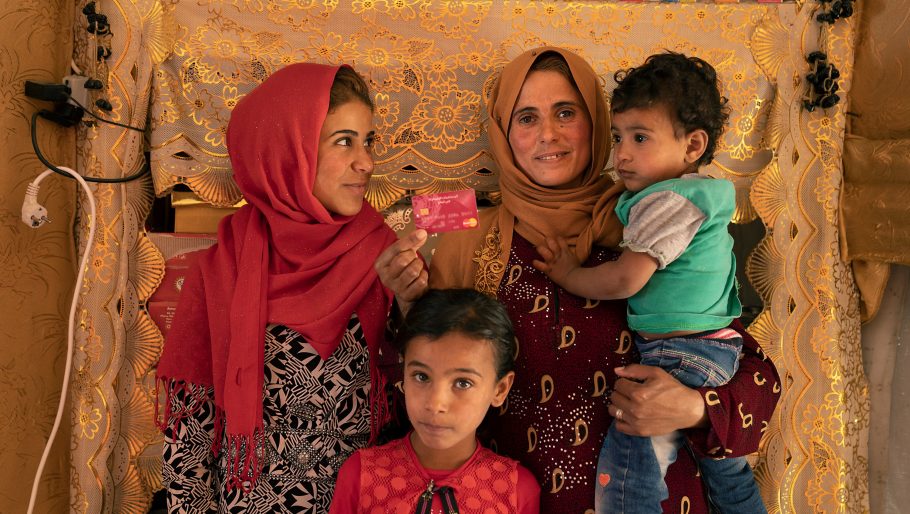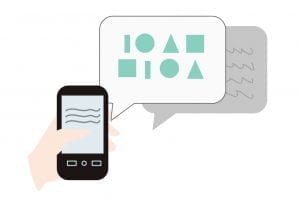Moving the dial on participation via CVA

Introduction
Whilst in principle there is a widespread commitment to greater participation of people affected by crises in shaping aid responses, we haven’t yet seen system wide transformation when it comes to accountability to the individuals and communities we exist to support. Could CVA be a catalyst that helps shift the narrative?
The end of the Grand Bargain 1.0 prompted reflections about why the ambitions to create a ‘participation revolution’ have not materialized as hoped. Agencies have struggled to prioritise and resource the capacities needed to meaningfully listen to recipients and create opportunities for participation.
Here we look at four key areas in which new accountability practices and models are emerging from CVA programmes which could inspire improved participation approaches across the sector.
1. Reimagined accountability systems and more sophisticated data driven approaches
Aid is being delivered at an unprecedented scale because of CVA, which has laid bare the reality that traditional accountability and monitoring systems are not sufficient. Delivery through harmonized systems and common platforms, handling high volumes of feedback and complaints, which can run into thousands of calls per month, and explaining complex targeting approaches in a way that promotes trust and transparency are just some of the crucial demands of ‘big cash’.
These require new types of data sharing agreements, reimagined accountability systems, more sophisticated data driven approaches, and new ways to communicate and consult with recipients. Designing accountability systems for programmes reliant on automated processes and limited face-to-face contact has arguably equipped big cash actors to adapt to the COVID-19 pandemic. For example, programmes like the Emergency Social Safety Net (ESSN) in Turkey have been able to continue consultations with and support to the 1.7 million people it assists, despite the need to reduce face-to-face interaction and the complexity of consulting people remotely.
Large-scale cash programmes with different actors playing a role per phase of the programme cycle, to reinforce accountability, is also a concept gaining traction. We see this through CAMEALEON in Lebanon, an NGO led network providing independent MEAL to a cash assistance programme delivered by WFP and currently assisting more than 300,000 Syrian refugees, with a particular focus on ensuring that recipient experiences and preferences are factored into programme adaptations and decision-making.
By connecting the analysis of high-volume data with reflections on organisations’ experiences running these extensive systems, CVA programmes offer important learning for feedback mechanisms at scale, especially during a pandemic.
2. Charting user experiences to ensure a human-centred approach
Cash highlights how programme participants’ experiences are an integral part of understanding programme results. Being part of a CVA programme means participants also have responsibilities, such as attending validation appointments, cashing out assistance, obtaining identification, and keeping payment mechanisms safe yet accessible. It also places cash recipients within a bigger ecosystem of people they need to interact with – not just humanitarian staff, but financial service providers, call centre operators, and support networks that extend beyond project activities. User experiences should, and are, starting to be considered more systematically to better understand how people navigate these systems.
‘User journeys’, for example, chart people’s interactions with a product or service to create empathy with and improvements for intended users. This human-centred design tool has become a core element in product development and design in the private sector, and has been used in humanitarian cash responses by actors such as Ground Truth Solutions. . Listening to aid recipients on their terms shifts the perspective in favour of starting with people, as the Humanitarian Advisory Group and others recommend.
Why is this important? Without understanding these experiences, we risk undermining the well-being benefits of cash. It isn’t possible to assist everyone, but documenting the lived experiences makes us aware of the unintended consequences of our efforts to drive efficiency at scale. We need to generate the stats to demonstrate programme impact, but we also need to understand people’s stories.
3. Improving technology informed by a better understanding of user-barriers
How do participants navigate programme related technology? Most CVA programmes would not be feasible without technology, and certainly not at scale. Digital payments have been a major factor in the scale up of CVA, and inform a lot of aid-related communication channels and accountability systems. However, most CVA programmes are often, by nature, designed for the ‘average user.’
There is growing knowledge about how some recipients often have to develop their own strategies or networks – financial and social – to overcome the technology related barriers they face. For example, CAMEALEON’S research in Lebanon highlighted that participants generally understood monthly SMS messages about loading cash transfers, but with high levels of illiteracy, some refugees have to employ creative strategies such as learning to decipher messages without reading them or asking others to read the SMS for them. As one recipient explained: “On the fifth of every month I get an SMS and I can tell what it is from the shape of the text and the number. I know the number. It ends with 300. Only the loading SMS has my file number. Sometimes I ask the neighbour to read it to me.”

GSMA and Ground Truth Solutions in Burundi underlined examples of where, by sticking to CVA best practices such as ensuring the “right” (i.e., most vulnerable) people are the ones receiving the cash, recipients were unintentionally discouraged from asking others for help to withdraw their assistance. “They told us that if we give anyone our SIM cards, they could cheat us and steal our money,” one woman told GSMA during the user journey interviews. While that is certainly a risk in any context, this perspective illustrates the personal conflict between people needing support to use the card but not wanting to disobey programme instructions.
Knowing more about personal strategies to deal with programme technology and differentiating between those that are positive and consensual and those which are potentially exploitative, enables us to better leverage technology to support all recipients and anticipate their needs in future programmes.
4. Including recipient perspectives in cost-benefit analyses
The dilemmas surrounding the cost benefit of accountability are brought to the fore by cash programmes. CVA programmes provide tangible figures on how much funding directly reaches aid recipients as a proportion of the overall programme cost (total cost to transfer ratio). Whilst the reality is clearly more complex, each dollar spent on programme costs is ultimately a dollar that recipients don’t receive. This brings into sharper focus the difficult trade-offs for cash actors, between striving for better accountability systems (that come with operational costs) and managing the challenging realities of programming. Organisations are also under increasing pressure to “get it right” from the beginning and demonstrate value for money to funders and taxpayers.
This is an important part of programme accountability but creates the risk that this focus detracts from the “people-first” approach we know could enable more meaningful accountability. Being part of a humanitarian programme also often costs recipients money – both directly and through opportunity losses of time away from employment to meet commitments of the programme, which are increasingly being monitored in cash programmes. For example, Key Aid Consulting have been at the forefront of efforts to include the perspectives of recipients in Value for Money assessments of CVA programmes, posing the question of Value for Money for who?. Their latest work underlines how organisations’ drive for efficiency at scale may increase recipients’ cost to participate, for example.
CVA programmes create the opportunity to measure aid efficiency more consistently, such as with total cost to transfer ratios, but also to reimagine a more people-centred approach to value for money – one that considers accountability trade-offs between the priorities of aid providers and recipients.
Conclusion
People’s perspectives should be the starting point and a constant metric in all responses, particularly when it comes to understanding their situations, their confidence in the system, and how they see it working to support them. We need an evolved definition of aid ‘success,’ with recipient perspectives featuring more prominently in our performance metrics – not just satisfaction, also ratings of their experiences being part of CVA programmes and the quality of assistance they receive. These in turn must inform future CVA programme design.
Although there is still a long way to go to achieve this vision, thinking and emerging practices in the cash sphere have already generated important learning on how it can be done. We should be continuing to look for inspiration of good practices outside our sector, but also be confident that solutions can come from within, and crucially from involving the communities we support from the start.
In the photo: A Syrian refugee family receiving multi-purpose cash assistance, pictured in their tent in Lebanon. Credit: Adrian Hartrick, CAMEALEON.
About the authors:
 Liz Hendry is Consortium Manager of CAMEALEON, a cash research, accountability and learning network in Lebanon, co-led by the Norwegian Refugee Council (NRC), Oxfam and Solidarités International. She has worked in the humanitarian and development sectors for fifteen years, including for NRC, the British Red Cross, UNAIDS and on the organization of the International AIDS Conference.
Liz Hendry is Consortium Manager of CAMEALEON, a cash research, accountability and learning network in Lebanon, co-led by the Norwegian Refugee Council (NRC), Oxfam and Solidarités International. She has worked in the humanitarian and development sectors for fifteen years, including for NRC, the British Red Cross, UNAIDS and on the organization of the International AIDS Conference.
 Louisa Seferis is an independent consultant with 14 years of humanitarian experience. Her current portfolio includes technical support and learning on CVA, livelihoods, shock responsive safety nets, and people-centred aid with the IFRC, the Somali Cash Consortium, and the Norwegian Refugee Council. Prior to consulting, she managed the Cash Barometer initiative at Ground Truth Solutions and led the Danish Refugee Council’s work on economic recovery programming.
Louisa Seferis is an independent consultant with 14 years of humanitarian experience. Her current portfolio includes technical support and learning on CVA, livelihoods, shock responsive safety nets, and people-centred aid with the IFRC, the Somali Cash Consortium, and the Norwegian Refugee Council. Prior to consulting, she managed the Cash Barometer initiative at Ground Truth Solutions and led the Danish Refugee Council’s work on economic recovery programming.


